Sarah Browning, Extension Educator
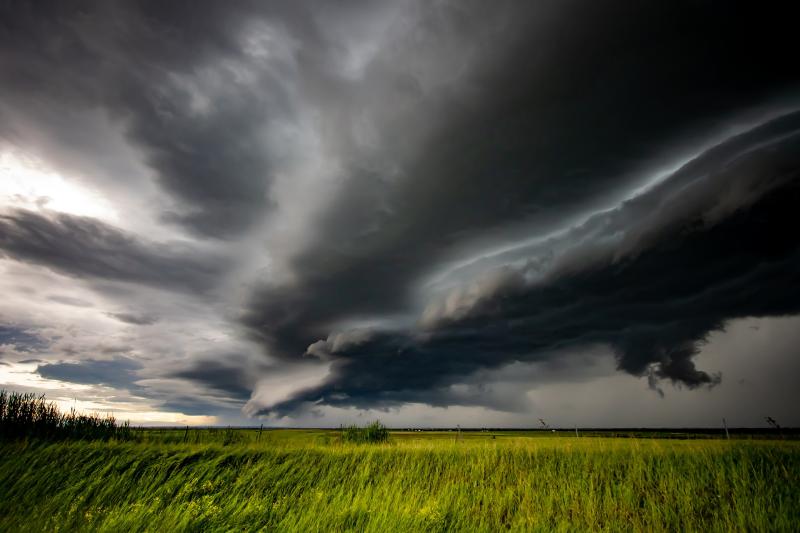
Nebraskans have seen their share of severe weather in recent weeks and as a result many landscape plants have been damaged by high winds and hail. Pixabay.com
Severe weather season has begun, with many experiencing damage in trees and landscape plants last week. Managing the effects of tornadic winds and hail is necessary to make the landscape safe again and help plants recover.
Damage Assessment
Broken tree limbs or fallen trees, creating dangerous situations in a home landscape. When large trees fall, it’s best to contact an arborist capable of providing emergency tree care in a safe manner while reducing further risk to property.
When branch damage is suspected look for broken, split or hanging branches up in the canopy and possible splits in the tree’s trunk. If their removal requires working up in the tree canopy, it’s best to contact an arborist. But many homeowners can handle failure of smaller trees or limbs that can be cut from the ground.
More information:
- Immediate Care for Storm-Damaged Trees, Nebraska Forest Service
- Caring for Storm-Damaged Trees, Colorado State Forest Service
Leaning Trees
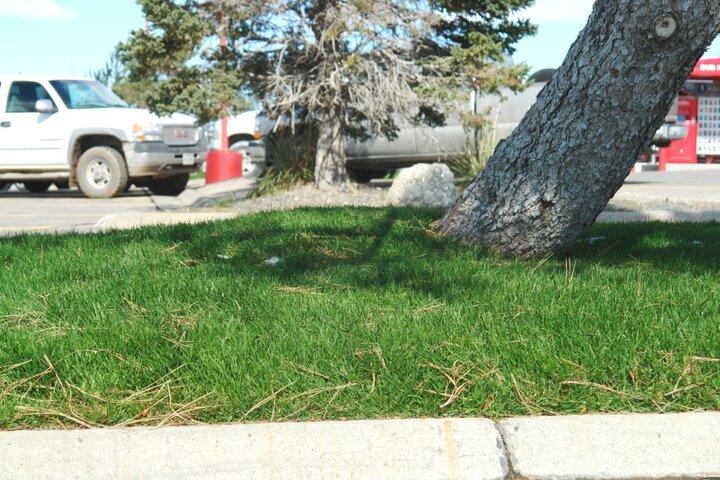
Saturated soil and high winds can result in trees pushed to one side. Even though it can’t be seen, roots have been broken causing a severe injury to the tree.
Mature trees rarely survive attempts to pull them back into place. They should be removed and replaced with new trees.
Very young trees may survive if gently pulled back to a vertical position. Stake the tree and press out any air spaces in the soil surrounding the tree. Apply 2-4 inches of wood chip mulch around the base of the tree and keep it well watered during dry periods for the rest of the growing season.
Damaged Branches or Trunks
Twisted and broken tree branches are another aspect of storm damage. All loose or hanging branches should be removed as soon as possible. Branches that are cracked, split or
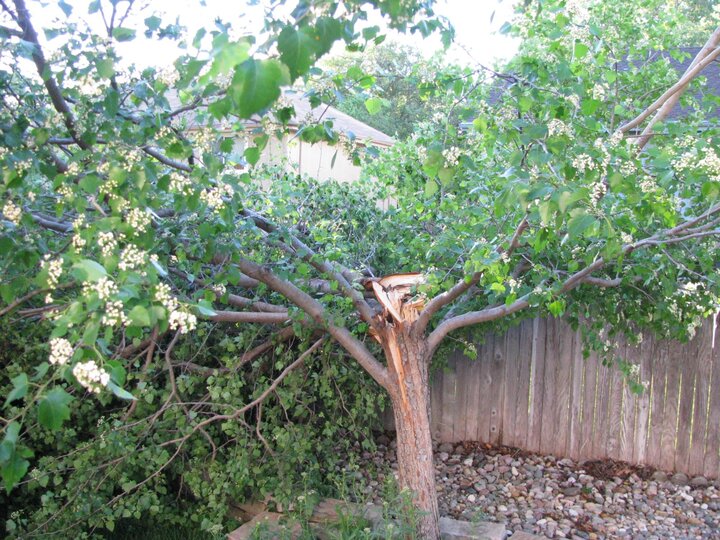
twisted should be removed next.
Branch stubs left by storm damaged should be given a clean cut, using good techniques so stubs are eliminated but only branch wood is removed. This results in a smaller wound, allows the tree to seal the wound more effectively and minimizes the chance of wood decay fungi entry into the trunk.
Trees split down the middle are very difficult to brace adequately and should be removed by a professional arborist.
Use Good Pruning Techniques
When removing damaged branches, if possible, make cuts so only branch wood is removed and the trunk is not injured. If only branch wood is removed, wounds are smaller, the tree will be able to seal the wound more effectively, and the chance of problems with wood decay are greatly reduced.
To locate the proper place to make a pruning cut, first look for the "branch bark ridge" on the upper surface of the branch where it joins the trunk. This is a line of bark pushed up between the branch and trunk as they grow. (Some branch unions will not have this if they did not form properly. Instead the branch will simply press into the supporting stem, forming a sharp V-shaped union.)
On the underside of the branch look also for the "branch collar", which is a slightly swollen area of trunk tissue that wraps around the base of the branch. A proper pruning cut begins just outside the branch bark ridge and angles down and slightly away from the trunk, avoiding injury to the branch collar.
Remove heavy branches using the 3-cut method.
1. First, cut into the underside of the branch, approximately 8-10 inches from the tree's trunk, going less than half way up through the branch. This cut does not remove any of the branch - its purpose is to prevent the branch bark from ripping down the trunk when the branch falls away.
2. Second, make a cut an inch or two further out from the first cut (away from the tree trunk) removing the majority of the branch. The second cut should be made from the topside of the branch down.
3. Third, remove the remaining stump, also going from the top of the branch down. Be careful not to cut into either the branch bark ridge or the branch collar.
Wound dressing is not recommended as a standard practice anymore. However, if oak or American elm suffer summer storm damage and require remedial pruning, a wound dressing should be used to prevent infection by oak wilt or Dutch elm disease.
Know When to Hire an Arborist
Pruning trees is dangerous work, especially when it involves working up in a tree’s canopy or using power equipment. At these times it’s best to hire a professional arborist who
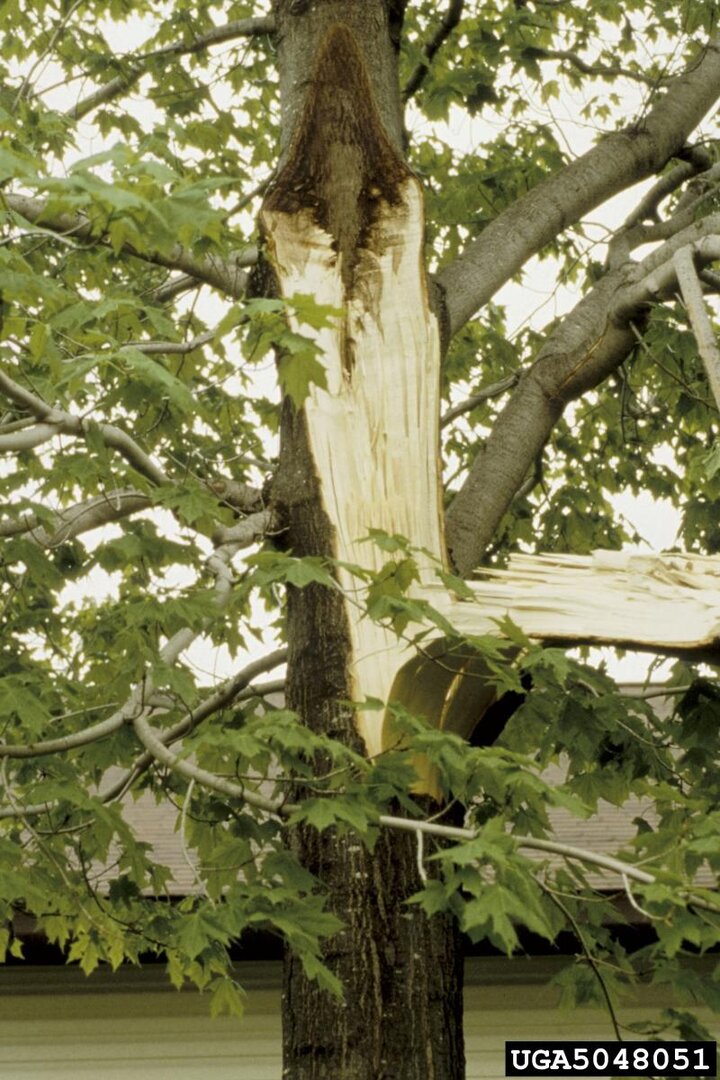
can determine what type of pruning is necessary to salvage the tree’s health, while maintaining its appearance and safety. They also have the skills and equipment necessary to safely remove trees too damaged to save.
Check the Yellow Pages or Google certified arborists with either the International Society of Arborists, or Nebraska Arborist Association.
Ask for proof of insurance. A reputable arborist will have personal and property damage insurance as well as workers compensation insurance. Ask for references to find out where the company has done similar work. Get more than one estimate and don't always accept the lowest bid. Examine the submitted bids and determine the best combination of price, work to be done, skill and professionalism to protect substantial investments.
Hail Damage
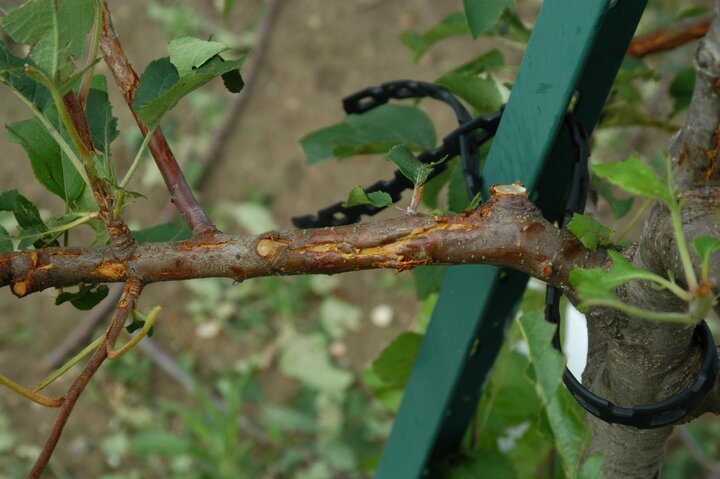
Minor hail damage, such as holes in the leaves of hosta or slight defoliation of trees and shrubs, can be survived. In most cases, nothing needs to be done by the gardener except to provide good basic care for the remainder of the growing season including deep infrequent irrigation when summer conditions turn dry.
Major damage includes 1) stripping of 50% or more of plant foliage, 2) pocks or tears in tree bark with damage to the underlying xylem and phloem tissues, 3) shearing of evergreen buds from branch terminals, 4) death of evergreen buds due to impact damage, and 5) broken tree or shrub branches.
Damage to a tree’s vascular system limits its’ ability to move water up from the roots and into the secondary branches and leaves. Movement of nutrients throughout the tree is also reduced. Over the next few years, previously healthy vigorous trees will produce callus tissue to seal off bark wounds and re-establish vascular function. Until then, they have a reduced ability to move water and cope with dry conditions, which in Nebraska are often exacerbated by high winds that accelerate water loss from leaves.
In most cases, homeowners should take a “wait and see” attitude. Trees and shrubs should be kept well-watered throughout summer and fall to avoid drought stress. Keep plants well mulched to prevent secondary injury from mowers and string trimmers. Prune out any branches which die completely.
Evergreens. Secondary pests, such as borers and aphids, should be controlled to avoid additional stresses. Sphaeropsis tip blight and diplodia needle blight can be serious problems in Austrian and Pondersosa pine trees following serious hail injury. Fungicide applications should be planned to keep infection to a minimum.
Diseases of Evergreen Trees, Nebraska Forest Service.
Fruit trees. Copper fungicide applied to damaged fruit trees will help protect wounds from infections by common pathogens like brown rot, bacterial canker, bacterial spot, and fire blight.
How should fruit growers respond to hail and severe storms?, Michigan State University.
Do not wrap the tree trunk or branches, as this creates a hidden area where insects can cause damage without being seen.
Do not automatically fertilize trees and shrubs to "help them recover." Fertilizer may not be needed and can be detrimental by forcing the tree to produce fast-growing lush foliage, at the expense of other recovery efforts such as root growth or wound closure. If the tree is growing in a lawn which is fertilized during the summer, then it’s getting plenty of fertilizer already.
Perennials. For hostas and other perennials which suffered severe hail damage, its best to remove the leaf debris with broken stems but allow the remaining foliage with intact stems to stay even though it is ragged and tattered. When new growth begins to appear, the tattered leaves can gradually be removed.
Removing all of a plant’s foliage at once by cutting it back to the ground will ultimately reduce plant vigor. The plant will be forced to use stored energy reserves to regrow new leaves without the benefit of any photosynthetic foliage to aid the regrowth.
Hostas: University of Minnesota Extension.
Search Our Archive
Associated Video
Storm Damaged Trees
UNL Director of Landscape Services Jeff Culbertson discusses tips to safely prune storm damaged trees. July 30, 2023